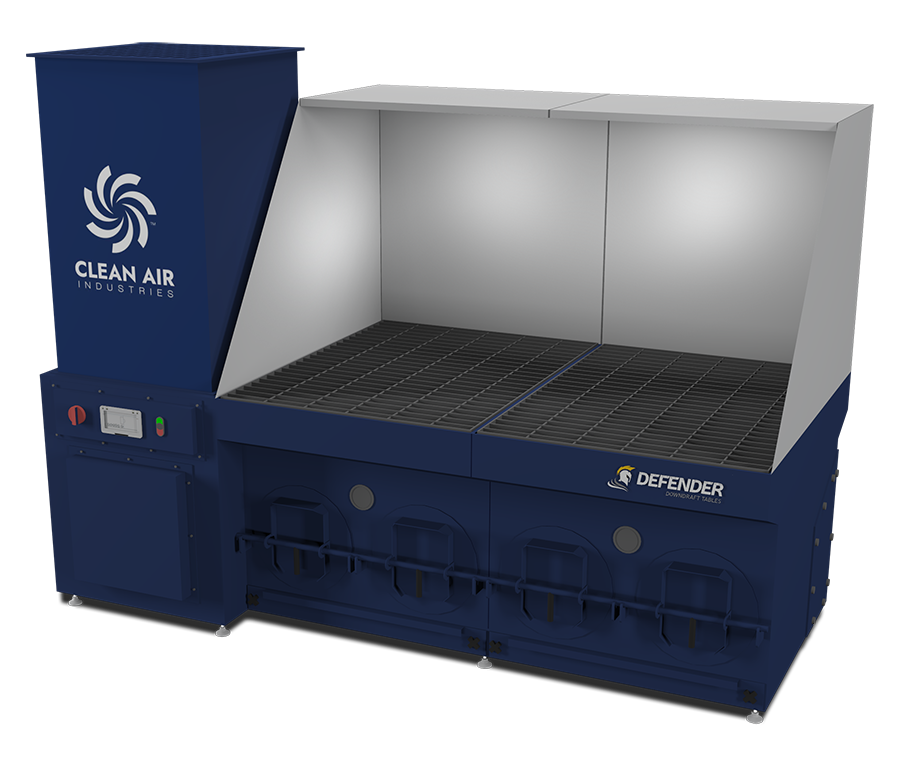Unlocking Workplace Safety and Efficiency: The Importance of Downdraft Tables in Manufacturing
Imagine a bustling manufacturing facility, the rhythmic hum of machinery, and dedicated workers striving to meet production targets. In this scene, safety should never be an afterthought. Yet, accidents and health hazards can loom over even the most well-run operation.
In this blog post, we’ll delve into the world of downdraft tables, their invaluable role in manufacturing, and how they not only boost productivity but also help prevent injuries and illnesses. We’ll share compelling statistics and data to underscore their significance in maintaining a safe and healthy workplace.
The Vital Role of Downdraft Tables in Manufacturing
In the dynamic world of manufacturing, where efficiency and productivity are king, the health and safety of workers often hinge on the equipment used. Among these, downdraft tables play a pivotal role. These specialized workstations are designed to capture and contain harmful dust, debris, and fumes right at the source, before they can invade the breathing space of workers.
The Invisible Threat in the Air
According to the Centers for Disease Control and Prevention (CDC), an estimated 558,000 workers in the USA are exposed to hexavalent chromium, a common compound in manufacturing [1]. Prolonged exposure to hexavalent chromium can lead to serious health issues like lung cancer and chronic obstructive pulmonary disease (COPD). Downdraft tables are instrumental in mitigating these risks by providing a localized extraction and filtration system.
A Statistical Perspective on Workplace Health
The implementation of downdraft tables has shown a marked improvement in workplace health. A study by the Journal of Occupational and Environmental Hygiene revealed that the use of local exhaust ventilation, like downdraft tables, can reduce airborne contaminants by up to 95%. This reduction significantly lowers the risk of respiratory diseases, which account for about 24% of all work-related illnesses in the manufacturing sector [2].
Beyond Health: Enhancing Productivity and Quality
Downdraft tables not only safeguard health but also enhance overall productivity and product quality. By removing airborne contaminants, they provide a cleaner work environment, leading to fewer machine malfunctions and lower maintenance costs. Moreover, a healthier workforce is invariably more productive and less prone to absenteeism due to illness.
The Economic Impact of Improved Safety
Investing in downdraft tables is not just a health and safety measure; it’s a smart economic decision. The National Safety Council estimates that work-related injuries and deaths cost the U.S. economy $167 billion in 2021 alone [3]. By preventing such incidents, downdraft tables contribute to reducing these enormous costs.
A Call to Action for Safer Workplaces
The story of downdraft tables in manufacturing is one of silent guardianship. They stand as a testament to the fact that the best safety measures are often those that go unnoticed, seamlessly integrated into the daily workflow. As we continue to advance in industrial practices, let’s not forget the importance of such equipment in safeguarding the health and well-being of our workforce. After all, a healthy worker is the true backbone of any successful manufacturing operation.
Downdraft tables might seem unassuming, but their impact on manufacturing settings is profound. They not only shield workers from harm but also bolster production efficiency. As the statistics demonstrate, these tables are an investment in both the well-being of your workforce and the bottom line of your business.
Incorporating downdraft tables into your manufacturing facility isn’t just a safety measure; it’s a strategic decision to secure a healthier, more productive future. By doing so, you’re not only protecting your employees but also fortifying your company’s position in the competitive manufacturing landscape.
Remember, in the world of manufacturing, safety is not just a priority – it’s a responsibility. Downdraft tables, with their proven track record, are here to help you fulfill that responsibility with excellence.
References
- Centers for Disease Control and Prevention (CDC). “Occupational Exposure to Hexavalent Chromium” [Online]. Available: https://www.cdc.gov/niosh/docs/2013-128/pdfs/2013_128.pdf.
- U.S. Bureau of Labor Statistics. “Respiratory Conditions Due to Toxic Agents” [Online]. Available: https://www.bls.gov/.
- National Safety Council. “Work Injury Costs – 2021” [Online]. Available: https://injuryfacts.nsc.org/work/costs/work-injury-costs/.

